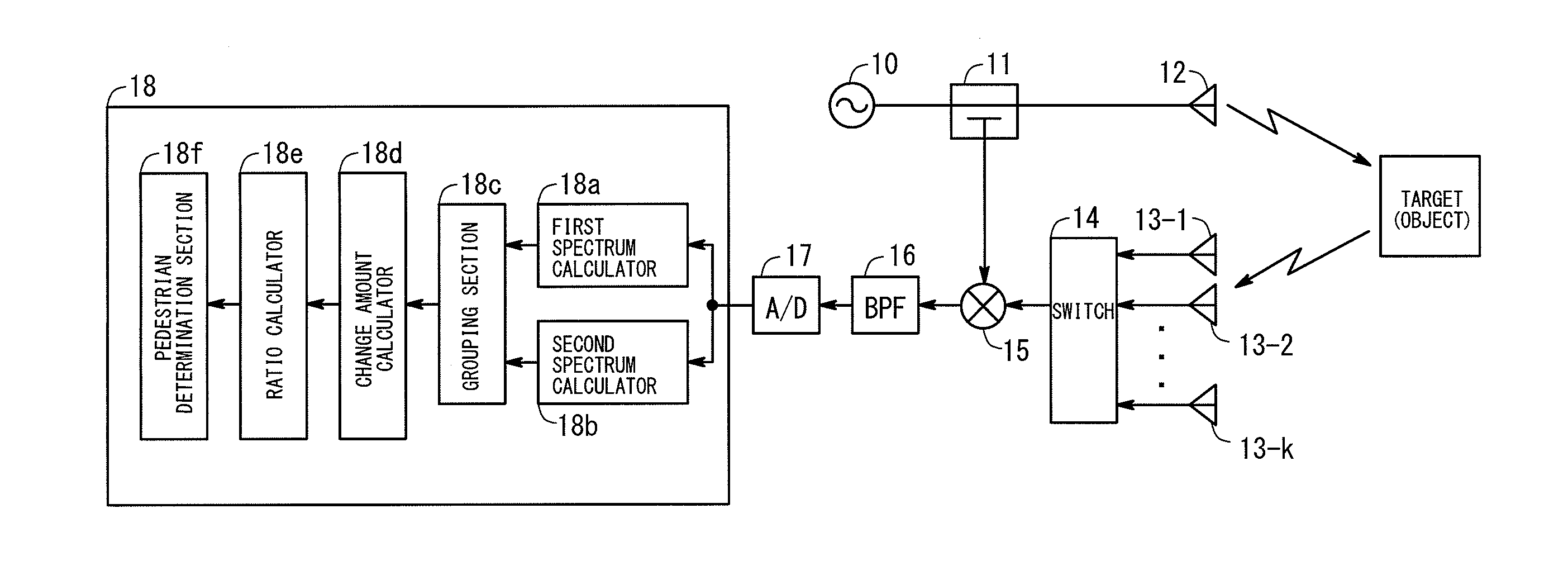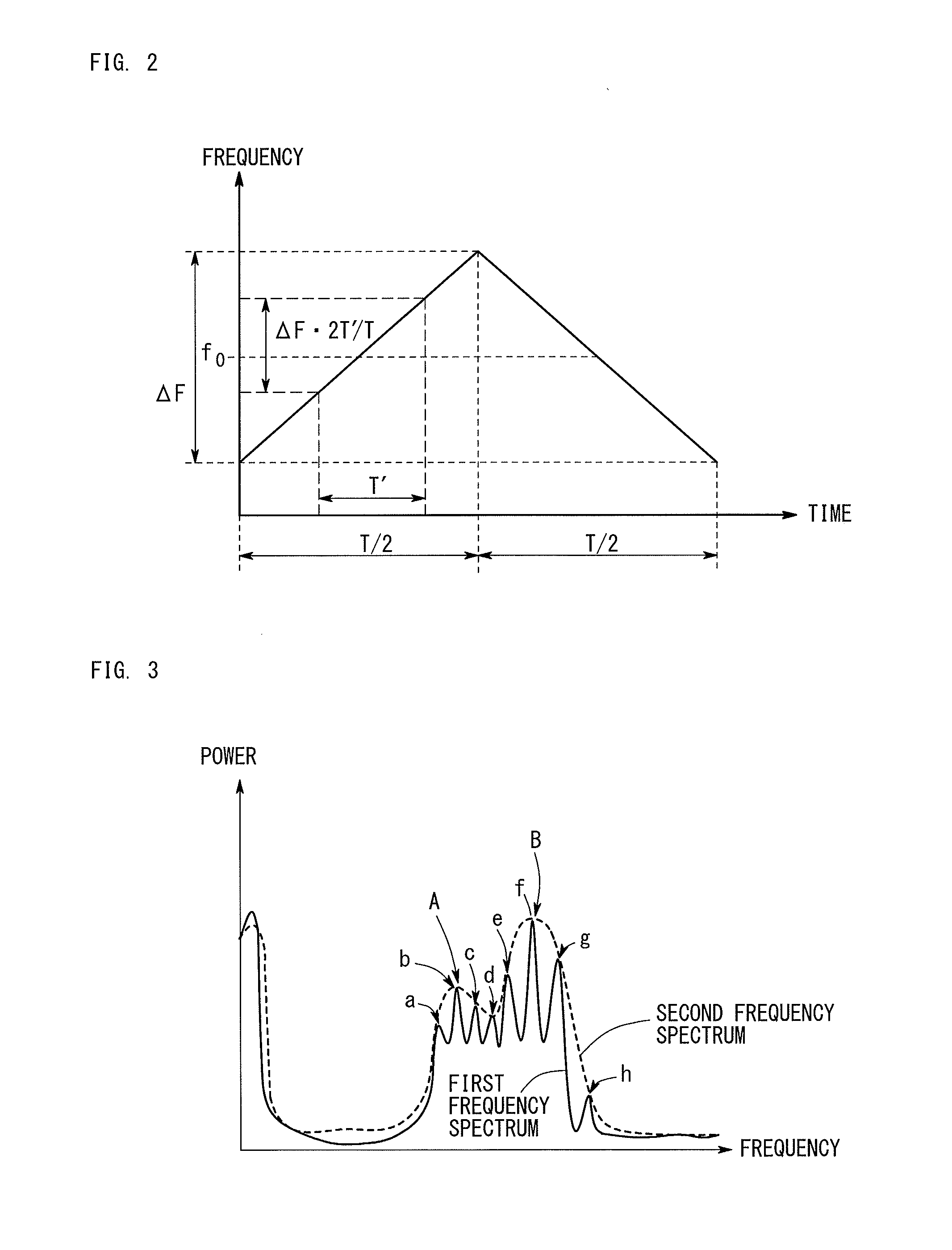Radar apparatus
a technology of a radar and a camera body, which is applied in the direction of instruments, measurement devices, and using reradiation, can solve the problems of increasing the cost of document 1 and the erroneous determination of the plurality of objects of the radar apparatus, and achieve the effect of accurately distinguishing a pedestrian and a vehicle from each other
- Summary
- Abstract
- Description
- Claims
- Application Information
AI Technical Summary
Benefits of technology
Problems solved by technology
Method used
Image
Examples
first embodiment
[0043]FIG. 1 is a block diagram showing the configuration of a radar apparatus according to a first embodiment. The radar apparatus of the first embodiment uses an FM-CW method for measurement of distance and velocity and uses a phase mono-pulse method for measurement of bearing. As shown in FIG. 1, the radar apparatus of the first embodiment is composed of an oscillator 10, a directional coupler 11, a transmitting antenna 12, K receiving antennas 13-1 to 13-K, a switch 14, a mixer 15, a band-pass filter 16, an AD converter 17, and a signal processing device 18.
[0044]Next, there will be described the configurations of the constituent elements of the radar apparatus of the first embodiment and its operation.
[0045]As shown in FIG. 2, the oscillator 10 oscillates a frequency-modulated signal (transmission signal). Specifically, the transmission signal is a triangular wave which has a period T, a frequency change width ΔF, and a center frequency f0. During a section of 0 to T / 2, the fre...
second embodiment
[0080]FIG. 4 is a block diagram showing the configuration of a radar apparatus according to a second embodiment. The radar apparatus of the second embodiment measures distance and velocity by a multi-frequency CW method. As shown in FIG. 4, the radar apparatus of the second embodiment has the same configuration as that of the radar apparatus of the first embodiment except that the oscillator 10 and the signal processing device 18 of the radar apparatus of the first embodiment are replaced with an oscillator 20 and a signal processing device 28, respectively.
[0081]The oscillator 20 oscillates a transmission signal whose frequency changes as shown in FIG. 5. The oscillator 20 repeats an operation of increasing the frequency of the transmission signal stepwise with time and returning the frequency to its initial value. As shown in FIG. 5, the frequency increases stepwise from f0 (initial value) to f0+Δf, then to f0+2Δf; i.e., at an increment of Δf, at time intervals t. When the number ...
third embodiment
[0091]FIG. 7 is a block diagram showing the configuration of a radar apparatus according to a third embodiment. The radar apparatus of the third embodiment performs distance measurement by a pulse method. Namely, the radar apparatus of the third embodiment measures the distance between the radar apparatus and an object from a time delay of a pulse. As shown in FIG. 7, the radar apparatus of the third embodiment has the same configuration as that of the radar apparatus of the first embodiment except that the oscillator 10 is replaced with an oscillator 30, a switch 39 is provided between the directional coupler 11 and the transmitting antenna 12, and the components and section on the output side of the mixer 15 are replaced with band-pass filters 36a and 36b, AD converters 37a and 37b, and a signal processing device 38. Portions different from those of the first embodiment are described below.
[0092]The oscillator 30 oscillates a signal of a continuous wave having a predetermined freq...
PUM
 Login to View More
Login to View More Abstract
Description
Claims
Application Information
 Login to View More
Login to View More - R&D
- Intellectual Property
- Life Sciences
- Materials
- Tech Scout
- Unparalleled Data Quality
- Higher Quality Content
- 60% Fewer Hallucinations
Browse by: Latest US Patents, China's latest patents, Technical Efficacy Thesaurus, Application Domain, Technology Topic, Popular Technical Reports.
© 2025 PatSnap. All rights reserved.Legal|Privacy policy|Modern Slavery Act Transparency Statement|Sitemap|About US| Contact US: help@patsnap.com



